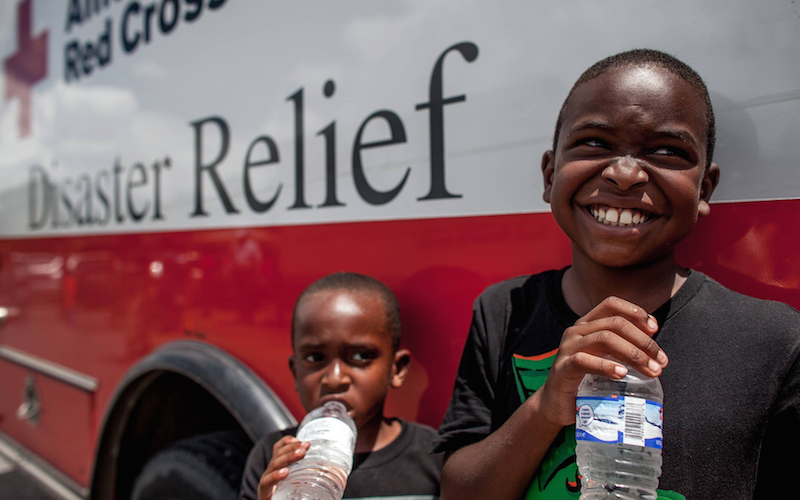
The Unbroken Chain in a Resilient Society
Across the U.S., like much of the world, fast-cycle news often drowns out pressing human challenges that should not only capture our attention, but garner our collective response over the long term. Marshaling a strong response to humanitarian crises often falls prey to a combination of volunteer or donor fatigue, resource scarcity and, quite simply, inattention. Stricken communities, like Louisiana or Ellicott City, Maryland, which have been affected by record flooding, and first responders, like the American Red Cross, who remain perennially stretched yet steadfast, lean on the broader community to support their response and recovery efforts. This community, meaning citizens of the United States and other countries around the world, must also lean in and help shoulder the financial, emotional and logistical burden of providing a national safety net.
The first link in the unbroken chain of a resilient society are prepared people in prepared households. The remaining links combine to form a chain of first responders, emergency preparedness and communities at the city, state and local level who are committed to long term resilience and recovery when disasters strike. Relief agencies like the Red Cross movement are often the one assurance vulnerable communities have when all else fails.
The numbers behind their ongoing mission in Baton Rouge are staggering; as of August 29th they had approximately 2,500 people living in their shelters, served more than 466,000 meals and snacks, distributed more than 210,000 relief items (mosquito repellent, gloves, bleach, etc.), provided more than 55,000 overnight stays for displaced families, fielded more than 27,000 calls from people seeking help, and have offered 12,000 health services and emotional support contacts.
The sight of The Red Cross or The Red Crescent icon is itself the sign of relief to communities around the world. Yet, the movement benefits from the kindness of strangers to support this invaluable organization through a wide range of options of engagement at the individual level. From volunteering time and effort, to donating money, to life-saving blood donations, people of all means can contribute to building a resilient society. Indeed, this is the ultimate form of investment, for in the collision of man-made and natural risks, rich, poor and everyone in between is in the crosshairs of an increasingly violent world.
Ironically, solving one of the more insidious challenges of sustaining long term relief efforts, such as those in flood-hit Louisiana or in other stricken communities around the world, is essentially free. Society must demand that progress reports on these “forgotten crises” become a part of our national and, indeed, global public discourse. When was the last time a live news report was given updating the U.S. on the status of Flint’s water crisis? When was the last time rebuilding efforts in Moore, Oklahoma were revisited on prime-time TV, months and years after the tornado’s destruction? Clearly competing for airwaves and attention with a 24-hour news cycle during a rabid electoral year is difficult, but after all, broadcast choices are driven by consumer preferences. Societal indifference, especially to the most vulnerable among us can be changed, particularly by highlighting the invaluable, thankless and courageous work of the few on the frontlines.
How can we as a society encourage more dedicated and continuous news coverage for groups like The American Red Cross? By taking action. During the next crisis citizens should consider taking a vacation from work, renting a SUV, and traveling to a disaster-stricken area equipped with canned food, flashlights, brooms, work gloves, work boots, and a big heart. These dedicated citizens should not interfere with emergency crews and relief organizations doing their jobs, rather they can “wait in the wings” for further instructions on how they can provide service. Driving to a local YMCA, church, mosque, or synagogue and asking how you can support a grief-stricken community is a great way to support the recovery efforts without interfering with them. The more citizens participate, the more the media cannot ignore the power of the people and the more we collectively humanize those in affected areas.
With the growth of social media and “self-reporting,” these generous citizens could even conduct their own podcasts and live-stream them on Facebook or other outlets to highlight the work of aid and relief agencies like the Red Cross and others. A smart phone has the ability to turn all of us into broadcast journalists, bearing in mind to stay out of harm’s way and clear of the first responders. We are the new media, just as much as we are the first link in the crisis response chain. Citizens living in these affected communities can also pick up their smartphones and provide updates in the months after a disaster has occurred, ensuring that recovery efforts will not be forgotten. Local politicians provide a steady presence in these areas and have the added benefit of keeping the cameras rolling long after a crisis has subsided.


